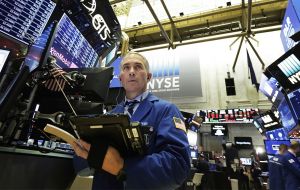MercoPress. South Atlantic News Agency
Fed raises basic rate to 2%; anticipates further increases amid strong economic growth
 Fed Chairman Powell announced that he will hold a press conference after every policy meeting, to give the Fed “more opportunities to explain our actions”
Fed Chairman Powell announced that he will hold a press conference after every policy meeting, to give the Fed “more opportunities to explain our actions”  Wall Street was not happy by the aggressive new stance, and all three major indexes turned negative right after the announcement, with the Dow down 0.23%
Wall Street was not happy by the aggressive new stance, and all three major indexes turned negative right after the announcement, with the Dow down 0.23% The US Federal Reserve raised the benchmark lending rate on Wednesday, the second increase of the year, and signaled it will be more aggressive about rate increases this year and next amid “strong” economic growth. The unanimous vote brings the federal funds rate to a range of 1.75 to 2%, but the quarterly economic forecasts show central bankers now expect the rate to end the year at 2.4% rather than the 2.1% projected in March.
That implies four total rate increases this year.
The Fed last raised the benchmark in March, the sixth increase since December 2015, as it tries to keep the economy growing at a sustainable pace without fuelling inflation.
The median forecast of members of the Fed's rate-setting Federal Open Market Committee (FOMC) puts the benchmark at 3.1% at the end of 2019, up from the previous 2.9%, which signals four hikes next year rather than three.
Wall Street was not happy by the aggressive new stance, and all three major indexes turned negative right after the announcement, with the Dow down 0.23%. Most economists had not expected the Fed to give a clear sign that an additional rate increase was likely until later in the year.
At his post-meeting press conference, Fed Chairman Jerome Powell also announced that he will hold a press conference after every policy meeting, rather than the current quarterly schedule. The change will start in January following the meetings that are scheduled roughly once every six weeks, to give the Fed “more opportunities to explain our actions,” Mr Powell told reporters.
But he said “having twice as many press conferences does not signal anything about the timing or the pace of interest rate changes”.
The FOMC statement stressed that rising interest rates were unlikely to derail economic growth - which the committee now characterizes as “strong” rather than “moderate” - and again made clear the Fed had some tolerance for inflation above its 2% target.
In another slight change of language - something sure to catch the attention of Fed watchers - it said “further gradual increases” in the key rate “will be consistent with sustained expansion of economic activity, strong labor market conditions and inflation near the Committee's symmetric two per cent objective over the medium term”.
The use of the terms “symmetric” and “medium term” is a clear indication the Fed is not in a hurry to get inflation to 2%, and will be comfortable if prices rise above that level for a short time.
The FOMC's economic growth forecasts were little changed, with 2018 GDP seen rising 2.8% rather than 2.7%, but unchanged at 2.4% in 2019, and 2% in 2020. The already historically low unemployment is projected to fall even further, ending the year at 3.6% before settling at 3.5% in 2019 and 2020.
Follows the FOMC release:
Information received since the Federal Open Market Committee met in May indicates that the labor market has continued to strengthen and that economic activity has been rising at a solid rate. Job gains have been strong, on average, in recent months, and the unemployment rate has declined. Recent data suggest that growth of household spending has picked up, while business fixed investment has continued to grow strongly. On a 12-month basis, both overall inflation and inflation for items other than food and energy have moved close to 2%. Indicators of longer-term inflation expectations are little changed, on balance.
Consistent with its statutory mandate, the Committee seeks to foster maximum employment and price stability. The Committee expects that further gradual increases in the target range for the federal funds rate will be consistent with sustained expansion of economic activity, strong labor market conditions, and inflation near the Committee's symmetric 2% objective over the medium term. Risks to the economic outlook appear roughly balanced.
In view of realized and expected labor market conditions and inflation, the Committee decided to raise the target range for the federal funds rate to 1-3/4 to 2%. The stance of monetary policy remains accommodative, thereby supporting strong labor market conditions and a sustained return to 2 percent inflation.
In determining the timing and size of future adjustments to the target range for the federal funds rate, the Committee will assess realized and expected economic conditions relative to its maximum employment objective and its symmetric 2 percent inflation objective. This assessment will take into account a wide range of information, including measures of labor market conditions, indicators of inflation pressures and inflation expectations, and readings on financial and international developments.
Voting for the FOMC monetary policy action were Jerome H. Powell, Chairman; William C. Dudley, Vice Chairman; Thomas I. Barkin; Raphael W. Bostic; Lael Brainard; Loretta J. Mester; Randal K. Quarles; and John C. Williams.




Top Comments
Disclaimer & comment rulesCommenting for this story is now closed.
If you have a Facebook account, become a fan and comment on our Facebook Page!